Guide to MS Teams Backgrounds
Microsoft Teams, one of the leaders in the collaboration space offers two ways for users to manipulate and transform their backgrounds. You can either blur out any activity behind you, smudging a messy office into an explosion of grey mess. Or you could pick from a list of custom/personal backgrounds to transform your office space.
While the blurred option was great when it was the only option, most of today’s users will probably prefer the custom route.
So, we will show you everything you could possibly need to know about Microsoft Teams backgrounds to get the best out of every video call.
I mean, what could be better than having your Monday meetings from a beach in the Bahamas, or on Mars?

What are background effects on Microsoft Teams?
On Microsoft Teams background effects are third-party user background visuals that can be added to your video feed.
The background effects utilize Teams built-in AI to change the real-time background and replace it with a unique background chosen by you.
This eliminates the hassle of experiencing embarrassing situations where your family members or friends might walk right into your background during an office or business meeting.
It also ensures that every participant of your meeting can focus on the issues at hand and not get distracted by background activity.
This is a feature that builds on Teams existing background blur option with total compatibility regardless of the color of the wall behind you.
History and development of Microsoft Teams backgrounds
The first version of the Microsoft Teams custom backgrounds feature called the Background Effects was released in April 2020.
Initially, it allowed only a background blur and pre-selected images, unless you used a workaround.
But the latest version got rolled out in the first week of June and Microsoft Teams Backgrounds Effects now includes an Add New button that you can use to upload your visuals. And controls for system administrators who may need to restrict its use.
If you could not use the background blur feature on your PC or Mac previously, you will notice that background effects work now.
Reason being that Microsoft extended its support for background effects to accommodate more computers from June 2020.
Before now they required you to have a CPU that supports AVX2. Microsoft has since relaxed this to include AVX, which accommodates devices like older computers and the Surfer Go.
How to change your background with Microsoft Teams
To change your Microsoft Teams background you’ll need:
- A laptop with a camera built-in or a high-def standalone camera
- Microsoft Teams access
When you’re prepping your audio and video in preparation for your meeting, hit the Background effects tab. You can find the option on the right-hand side of the mic button. It’s the 3 dot icon as seen below.

Next, click on Show Background Effects from the submenu that pops up.
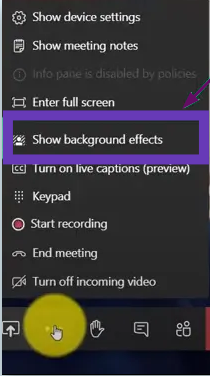
A sidebar will appear and you’ll then be able to see your background options on the right of your laptop’s screen.
Like this:

Scroll down to choose the one that best suits your needs and then hit Preview at the bottom of the sidebar.
Microsoft Teams allows you to preview a background before application, so you can ensure that you look as awesome as always.
Keep in mind that clicking the Preview button will switch off your video feed and show you a personal visual so you’ll be able to test out the available backgrounds on your own.
With that said, once the preview of your video feed is showing at the bottom of the sidebar on your laptop screen, you can test various backgrounds for the meeting to find the right one for your needs.
Once you’re satisfied with a particular background hit on Apply and Turn on Video.
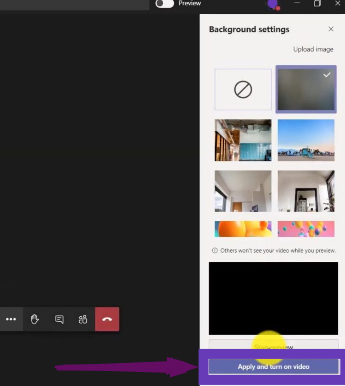
How to blur your background in Microsoft Teams?
If you only want to blur out your background, then you can do it in 1 of 2 ways.
Method 1: Before joining a video meeting or call
To blur out your background before you join in on a video call, toggle the background blur option so you go in ready.
Just tap on the video blur toggle on the last screen before your video call connects as shown below.

Method 2: During a call
You can also toggle in the background blur during a video call. Aside from the normal click-and-select, there’s also the keyboard shortcut that may come in handy.
Keyboard Shortcut
Hold CTRL + SHIFT + P to toggle on the background blur.
The conventional method to blur your background
During a video call, click on the 3 dot icon or Ellipsis. Then hit on Show background effects.

Microsoft Teams used to have a “Blur my background” option right there before the custom background feature was launched. But now, blur has been grouped with the custom backgrounds.
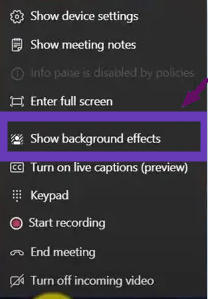
When the background settings submenu opens up on the right side of your screen, you see a list of custom backgrounds along with the blur option.
Next, click on the blur option, (which is usually right at the top) to select it. Then click on the preview button at the bottom of your screen to see how it’ll appear.
Click apply to get the blur effect on your video if you like what you see.
Your background will get blurred right away.
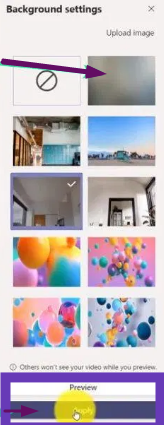
So you have the option of choosing an image to transform your background entirely or to just blur it.
Keep in mind though, that the ability to change your background on Microsoft Teams is only accessible to you if you’re not using a Linux OS. And if you aren’t accessing Teams via a Virtual Desktop Infrastructure (VDI)
How do I add my backgrounds on Microsoft Teams?
At the start, Microsoft only launched Custom Backgrounds with the option of just using images that were pre-picked by the brand.
This meant that you were unable to include your own visuals into your video meetings.
Now, although Microsoft was working on increasing the number of background images you could choose from, you had to depend on a workaround.
So let’s see how that worked and still works.
Method 1: Adding images manually to the uploads folder
If you’re bent on translating the freedom you’d get on Zoom to Microsoft Teams, then all you need to do is add your custom backgrounds via the Microsoft Teams folder from the PC version of the service.
To add your custom Teams background, go through the file system by using this navigation pathway on your Windows PC: %AppDATA%\Microsoft\Teams\Backgrounds\Uploads – copy and paste it into your Windows search bar to make the process easier.
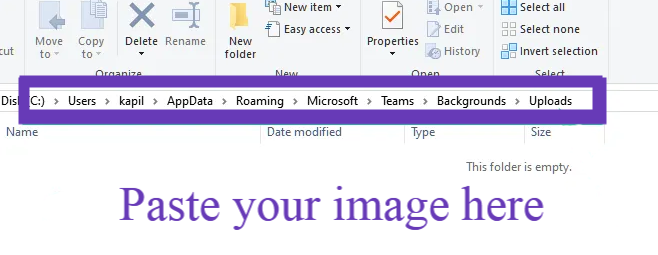
However, to use this workaround option you’ll need to be using the latest Microsoft Teams version. Ensure that your platform is properly updated before you look for custom backgrounds.
For Mac laptops, the same guidelines apply if you want to add personal images to Microsoft Teams. If you’re using a Mac, your backgrounds will show up within the Microsoft Teams client folder, so search for: /Library/Application Support/Microsoft/Teams/Backgrounds.
If you’re having a hard time locating the right library here, then hold down the option key.
Once you get access to the right folders on Mac or Windows, you’ll be able to add your own custom backgrounds with a few clicks.
Copy and paste the file you want to use as your background from documents or your pictures into the Microsoft Teams folder. Or you could drag and drop your visuals into place.
Once you’ve done this open up the Microsoft Teams client on your computer. Start a video call or meeting. Then hit on the 3 dot button in the calling bar menu at the bottom of your screen and click on Show background effects.
As we’ve already seen this will load background visuals on the right side of your screen. The new backgrounds that you copied and pasted to the uploads directory above on your Mac or Windows computer will also be available there.
But you may have to scroll down to find the new backgrounds you added. Hit on the background to select it, and then click apply to put it as your background.
Method 2: Add your own background images from within the Microsoft Teams desktop client
To add a unique background to Teams easily, just join or start a Teams meeting and hit on the 3 dot button on the meeting control menu at the bottom of your screen.
When the submenu appears, choose Show background effects from the options.

When the sidebar pops up on the right side of your screen, hit the + Add New button and choose an image from your library that you want to set as your meeting background.
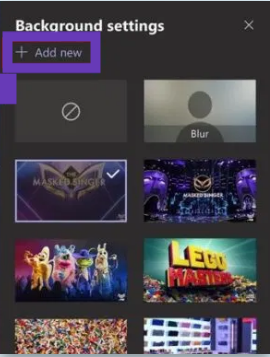
Your selected visual will be applied to the background settings sidebar and you can set it as your background for your Teams meetings.
Getting the best out of your custom backgrounds
In case you’re having issues accessing custom backgrounds, then you may want to update your Microsoft Teams client, or refresh it to see if it shows up.
However, if you’re unable to find the folders stated above, then you probably don’t have access to the feature.
It’s also recommended that you use high-quality visuals for your background if you want to get the best out of the service.
Use only high-resolution images and avoid visuals that may be copyrighted.
Next time you join a meeting, hit the Add new icon in the Background settings menu to add your custom image.
Recommended dimensions and formats
You can use JPG and PNG for your Microsoft Teams backgrounds. However, the best format to use is PNG and the best resolution is 1920×1080.
Some JPG image files store data like the camera rotation in the file’s metadata, rather than rotating the picture. And this makes Teams show the image upside down or at a weird angle.
PNG files don’t have this problem.
How to remove and manage unwanted uploaded backgrounds from teams?
While you’re able to add backgrounds to Teams, the option to delete them isn’t available.
If you’re confident in going the file route as we saw previously, then you can use that workaround to remove unwanted backgrounds.
It’s important to note that the file route is tricky and isn’t supported by Microsoft.
With that said, to find where your backgrounds are stored you can use the file path we used above.
For Windows paste the below into Explorer:
%AppDATA%\Microsoft\Teams\Backgrounds\Uploads
For Mac paste the below into Spotlight Search:
/Library/Application Support/Microsoft/Teams/Backgrounds
When you get to this folder, you’ll see the unwanted uploaded image file and another duplicate file beside it with a “thumb_” suffix.
Like this:

You need to delete both files from Teams to remove them. But if you want to hide them from the client, just delete the file with the “_thumb” suffix.
Where to get the best backgrounds for Microsoft Teams
If you’re looking for fun images for a social video call or a professional background for a business meeting, you can browse for relevant visuals on a variety of websites.
Let’s see them.
Huddlet
Here on Huddlet, we’ve got tons of outstanding background images that you can get for your video meetings. In categories like:
- Workspaces
Offices
Meeting rooms
Landmarks
Home interiors
Cityscapes
Architecture
Nature
Public spaces
Urban
And the list goes on. All you need to do is choose a payment plan and you’ll get access to over 600 amazing backgrounds. Including 100 + video backgrounds.
Airbnb
You may not be able to visit your desired resort destinations around the globe now, but you can use pictures from Airbnb to give an exotic feel to your meetings.
The website hosts several images from Mexico, Ireland, France, Norway, and other countries with visuals from a home on the beach to bamboo houses.
Fox Entertainment
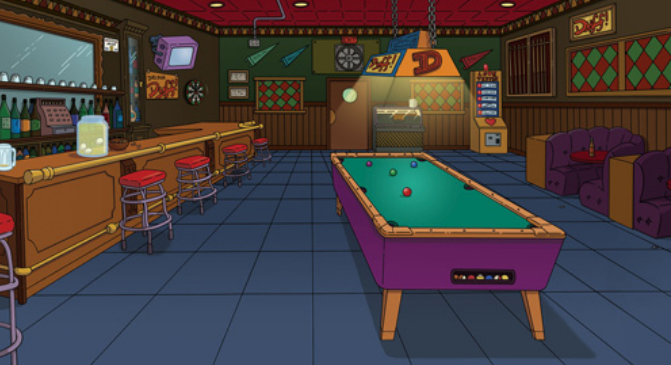
If you’re a huge fan of FOX TV shows like Family Guy, The Simpsons, you’ll see a host of background images at the FOX Microsoft Teams Backgrounds page.
The page even details how to save and include the images to Microsoft Teams.
Room for Zoom
Room for Zoom offers an awesome cavalcade of images for Microsoft Teams and Zoom. Most images are entertainment-themed with pictures from popular movies and TV shows.
However, the website also has images of famous outdoor landmarks and living areas.
Unsplash
Unsplash hosts 114+ images of offices, landmarks, rooms, homes, and other photos ideal for Microsoft Teams meetings.
All you need to do is hit the download arrow for any image you intend to use and you’ll be able to download it as a JPG file.
Canva

On Canva, most of the stellar images you’ll come across are for a fee. But you can also get several free background visuals.
You just need to click on the image you want to see a preview ad then download it as JPG or PNG.
Ikea
You can get a range of photos spotlighting celebrations, spaces, and offices on Ikea’s website.
Click a visual to download it as a JPG file or hit the link to download the bunch as a ZIP file.
How to Restrict Background Effects
Along with officially launching support for users being able to upload custom backgrounds, Microsoft released controls for IT administrators to restrict background effects usage.
You can control this through the New-CsTeamsMeetingPolicy and Set-CsTeamsMeetingPolicy cmdlets within the Skype for Business Online PowerShell module. These are available via the new VideoFiltersMode parameter.
Here are the options:
- BlurOnly – Only Background Blur
NoFilters – No Background Effects at all
AllFilters – Custom Images, Background Blur, and Default Backgrounds.
BlurAndDefaultBackgrounds – Only Default Backgrounds, Background Blur built-in to Teams
You can set a new Teams Meeting Policy to implement restrictions on a subset of users or change the global policy if you just have one policy and want to change it globally.
Here’s an example on how to change the Global policy to BlurAndDefaultBackgrounds:
Set – CsTeamsMeetingPolicy – Identity Global -VideoFiltersMode BlurAndDefaultBackgrounds
From the point of testing, the policy will take between half an hour to 3 hours to take effect.
Can you work around Microsoft Teams backgrounds restrictions?
If custom backgrounds are under restrictions, then the current files in your uploads folder won’t be available to pick from.
Meaning that if you cannot see your custom backgrounds again and you don’t have the Add New button, then your IT admin has put restrictions on the feature.
If you change a default background from the %AppDATA%\Roaming\Microsoft\teams\Backgrounds folder, then this won’t work. They are loaded every time you use them from a cache folder.
You can temporarily work around this by changing the cached version, but it won’t work reliably and will cause Teams to hang.
If you permit just background blur, then you won’t have the option to Add New and there also will be no selection of default backgrounds or a way to make them visible.
Is it possible to force a set of corporate backgrounds on Microsoft Teams?
No, it’s not. There is currently no way to force sets of corporate background through policies in Microsoft Teams.
If you intend to deploy corporate backgrounds, then you’ll need to permit custom images, and deploy them through a script to the %APPDATA%\Microsoft\Teams\Backgrounds\Uploads folder for each user.
One likely unsupported workaround you can use to force just the default background and a set of corporate backgrounds is to make a read-only folder on a user’s computer and load in the background image and the equivalent _thumb file.
Next, take out the uploads folder and create a symbolic link with the mklink command on an individual user basis from the uploads folder.
However, because of the complexity required to coordinate this efficiently, it’s better to wait until Microsoft Teams natively includes this capability within the service.
Which Microsoft Teams software version do you need for background effects?
To get the most recent background effects for Microsoft Teams you’ll need to update your PC client to the newest Microsoft Teams 3rd Anniversary Edition.
You can download the update directly from Microsoft’s website. If you’re using Windows, the exact version you need to download to your desktop client is v1.3.00.8663.
How can I get background effects feature?
This update isn’t available to all users currently as Microsoft is selectively rolling out the Background Effects feature to its users.
So as of now, there isn’t any workaround to enable it for your desktop app manually.
The best way to access this feature is to ensure that your desktop client stays up to date with regards to the latest Microsoft version 3rd anniversary edition.
You need to also check for updates regularly as Microsoft intends to regularly update the app with additional features in the coming months.
Why am I unable to change backgrounds on Microsoft Teams?
Initially, this new feature will only work for Microsoft Teams desktop clients on Windows and Mac.
However, if you’re using Windows or Mac computer and you still cannot change your background, then check if your Microsoft Teams application is up to date. If it isn’t, download the most recent version.
To do this, click on your profile picture at the top of your client screen and then select Check for updates.
Why can’t I see the show background effects option on my Microsoft Teams App?
As we’ve explained above, the recent Show background effects feature is available just for Microsoft Teams desktop clients for macOS and Windows.
Plus, since it’s a server-side update, it may take a while for the option to show up at your end. To ensure that you get the update on your Microsoft Team application, manually check and update the app on your Mac or Windows computer.
Conclusion
That’s a wrap! Microsoft Teams background effects make video calls a lot more engaging.
Now you don’t have to stick to only blurring out your background or pre-chosen images, but you can add unique images that’ll spice up your meeting.

